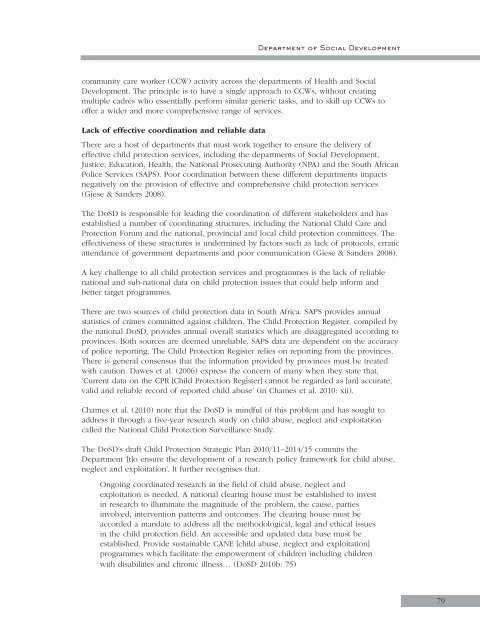Government-funded programmes and services for vulnerable - Unicef
Government-funded programmes and services for vulnerable - Unicef
Government-funded programmes and services for vulnerable - Unicef
Create successful ePaper yourself
Turn your PDF publications into a flip-book with our unique Google optimized e-Paper software.
Department of Social Development<br />
community care worker (CCW) activity across the departments of Health <strong>and</strong> Social<br />
Development. The principle is to have a single approach to CCWs, without creating<br />
multiple cadres who essentially per<strong>for</strong>m similar generic tasks, <strong>and</strong> to skill up CCWs to<br />
offer a wider <strong>and</strong> more comprehensive range of <strong>services</strong>.<br />
Lack of effective coordination <strong>and</strong> reliable data<br />
There are a host of departments that must work together to ensure the delivery of<br />
effective child protection <strong>services</strong>, including the departments of Social Development,<br />
Justice, Education, Health, the National Prosecuting Authority (NPA) <strong>and</strong> the South African<br />
Police Services (SAPS). Poor coordination between these different departments impacts<br />
negatively on the provision of effective <strong>and</strong> comprehensive child protection <strong>services</strong><br />
(Giese & S<strong>and</strong>ers 2008).<br />
The DoSD is responsible <strong>for</strong> leading the coordination of different stakeholders <strong>and</strong> has<br />
established a number of coordinating structures, including the National Child Care <strong>and</strong><br />
Protection Forum <strong>and</strong> the national, provincial <strong>and</strong> local child protection committees. The<br />
effectiveness of these structures is undermined by factors such as lack of protocols, erratic<br />
attendance of government departments <strong>and</strong> poor communication (Giese & S<strong>and</strong>ers 2008).<br />
A key challenge to all child protection <strong>services</strong> <strong>and</strong> <strong>programmes</strong> is the lack of reliable<br />
national <strong>and</strong> sub-national data on child protection issues that could help in<strong>for</strong>m <strong>and</strong><br />
better target <strong>programmes</strong>.<br />
There are two sources of child protection data in South Africa. SAPS provides annual<br />
statistics of crimes committed against children. The Child Protection Register, compiled by<br />
the national DoSD, provides annual overall statistics which are disaggregated according to<br />
provinces. Both sources are deemed unreliable. SAPS data are dependent on the accuracy<br />
of police reporting. The Child Protection Register relies on reporting from the provinces.<br />
There is general consensus that the in<strong>for</strong>mation provided by provinces must be treated<br />
with caution. Dawes et al. (2006) express the concern of many when they state that,<br />
‘Current data on the CPR [Child Protection Register] cannot be regarded as [an] accurate,<br />
valid <strong>and</strong> reliable record of reported child abuse’ (in Chames et al. 2010: xii).<br />
Chames et al. (2010) note that the DoSD is mindful of this problem <strong>and</strong> has sought to<br />
address it through a five-year research study on child abuse, neglect <strong>and</strong> exploitation<br />
called the National Child Protection Surveillance Study.<br />
The DoSD’s draft Child Protection Strategic Plan 2010/11–2014/15 commits the<br />
Department ‘[t]o ensure the development of a research policy framework <strong>for</strong> child abuse,<br />
neglect <strong>and</strong> exploitation’. It further recognises that:<br />
Ongoing coordinated research in the field of child abuse, neglect <strong>and</strong><br />
exploitation is needed. A national clearing house must be established to invest<br />
in research to illuminate the magnitude of the problem, the cause, parties<br />
involved, intervention patterns <strong>and</strong> outcomes. The clearing house must be<br />
accorded a m<strong>and</strong>ate to address all the methodological, legal <strong>and</strong> ethical issues<br />
in the child protection field. An accessible <strong>and</strong> updated data base must be<br />
established. Provide sustainable CANE [child abuse, neglect <strong>and</strong> exploitation]<br />
<strong>programmes</strong> which facilitate the empowerment of children including children<br />
with disabilities <strong>and</strong> chronic illness… (DoSD 2010b: 75)<br />
79
















